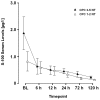Changes in S-100 protein serum levels in survivors of out-of-hospital cardiac arrest treated with mild therapeutic hypothermia: a prospective, observational study
- PMID: 19368739
- PMCID: PMC2689505
- DOI: 10.1186/cc7785
Changes in S-100 protein serum levels in survivors of out-of-hospital cardiac arrest treated with mild therapeutic hypothermia: a prospective, observational study
Abstract
Introduction: Knowledge about the influence of current neuroprotective interventions on prognostic markers after survival from cardiac arrest is lacking. This study aimed to investigate the effects of mild therapeutic hypothermia on the release of the astroglial protein S-100 after cardiopulmonary resuscitation (CPR) in survivors of out-of-hospital cardiac arrest.
Methods: This was a prospective, observational study performed during a two-year period, involving medical emergency services and five collaborating hospitals at the city of Aachen, Germany. Sixty-eight subjects were enrolled by the emergency physician on duty by taking blood samples after successful attempts at resuscitation with return of spontaneous circulation (ROSC), followed by samples at 6, 12, 24, 72 and 120 hours post ROSC by the appropriate intensive care unit staff. Depending on the decision of the attending physician, subjects were cooled down to 33 degrees C (n = 37) for 24 hours or were held at 37 degrees C (n = 31). Patients were tracked for estimating mortality and gross neurological outcome for 14 days.
Results: S-100 levels in patients not receiving mild therapeutic hypothermia (normothermia (NT)) showed equivalent numbers as compared with cooled patients (mild therapeutic hypothermia (MTH)) on baseline (NT = 1.38 mug/l versus MTH = 1.30 microg/l; P = 0.886). S-100 levels on baseline were significantly lower in patients with a good neurological outcome at 14 days after the event in comparison to their peers with adverse outcome (P = 0.014). Although the difference in S-100 levels of MTH patients with adverse or favourable neurological outcome reached statistical significance, it did not in NT patients.
Conclusions: Although the predictive power of S-100 levels were best on admission but not at later time points, MTH had no influence on S-100 serum levels in survivors of non-traumatic out-of-hospital cardiac arrest in the particular setting of this investigation.
Figures




Comment in
-
Can a simple blood test quantify brain injury?Crit Care. 2009;13(4):166. doi: 10.1186/cc7929. Epub 2009 Jul 15. Crit Care. 2009. PMID: 19664171 Free PMC article.
References
-
- 2005 American Heart Association guidelines for cardiopulmonary resuscitation and emergency cardiovascular care – part 3: overview of CPR. Circulation. 2005;112 (24 Suppl):IV1–203. - PubMed
-
- de Vreede-Swagemakers JJ, Gorgels AP, Dubois-Arbouw WI, van Ree JW, Daemen MJ, Houben LG, Wellens HJ. Out-of-hospital cardiac arrest in the 1990's: a population-based study in the Maastricht area on incidence, characteristics and survival. J Am Coll Cardiol. 1997;30:1500–1505. doi: 10.1016/S0735-1097(97)00355-0. - DOI - PubMed
Publication types
MeSH terms
Substances
LinkOut - more resources
Full Text Sources
Medical
Research Materials

